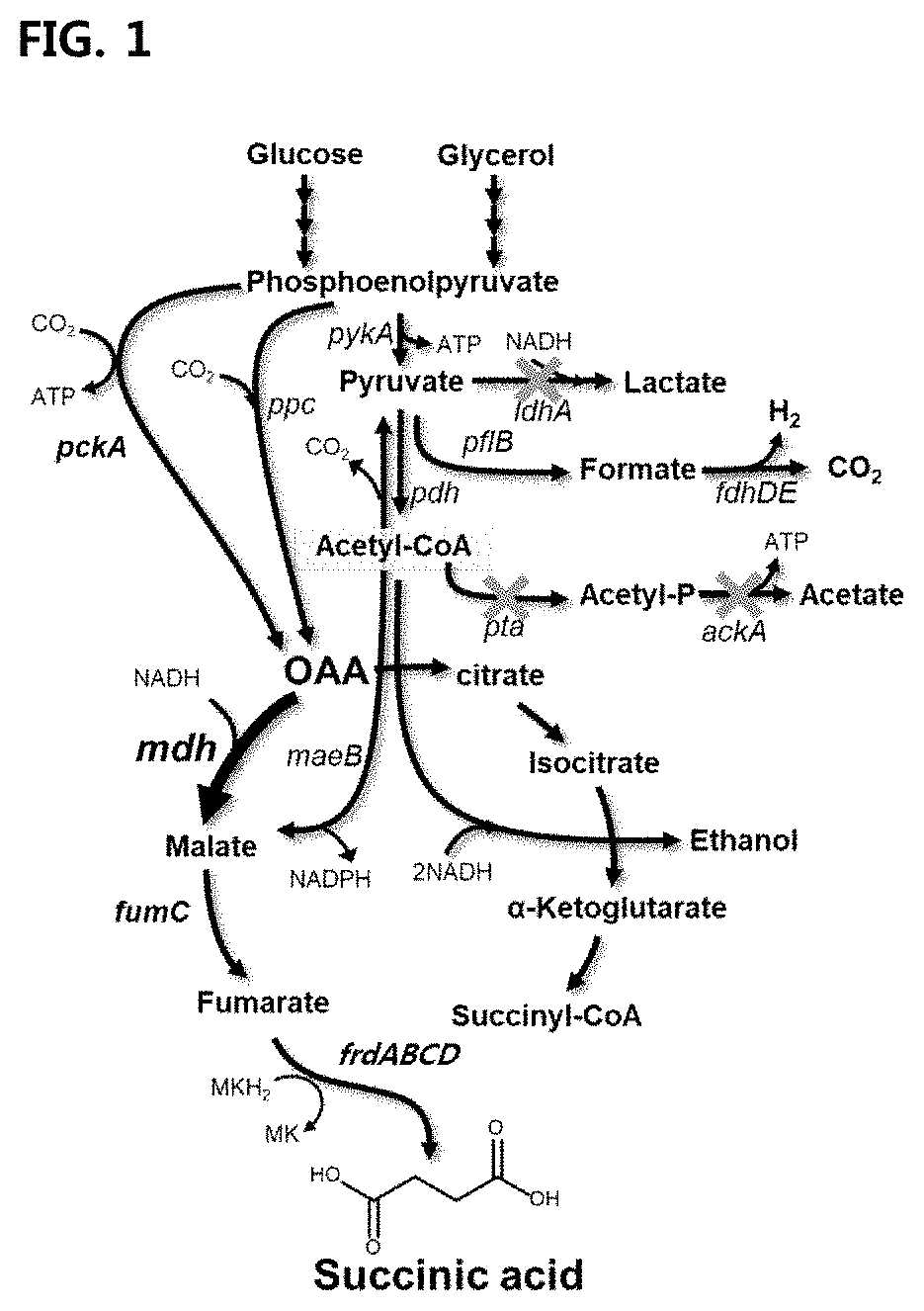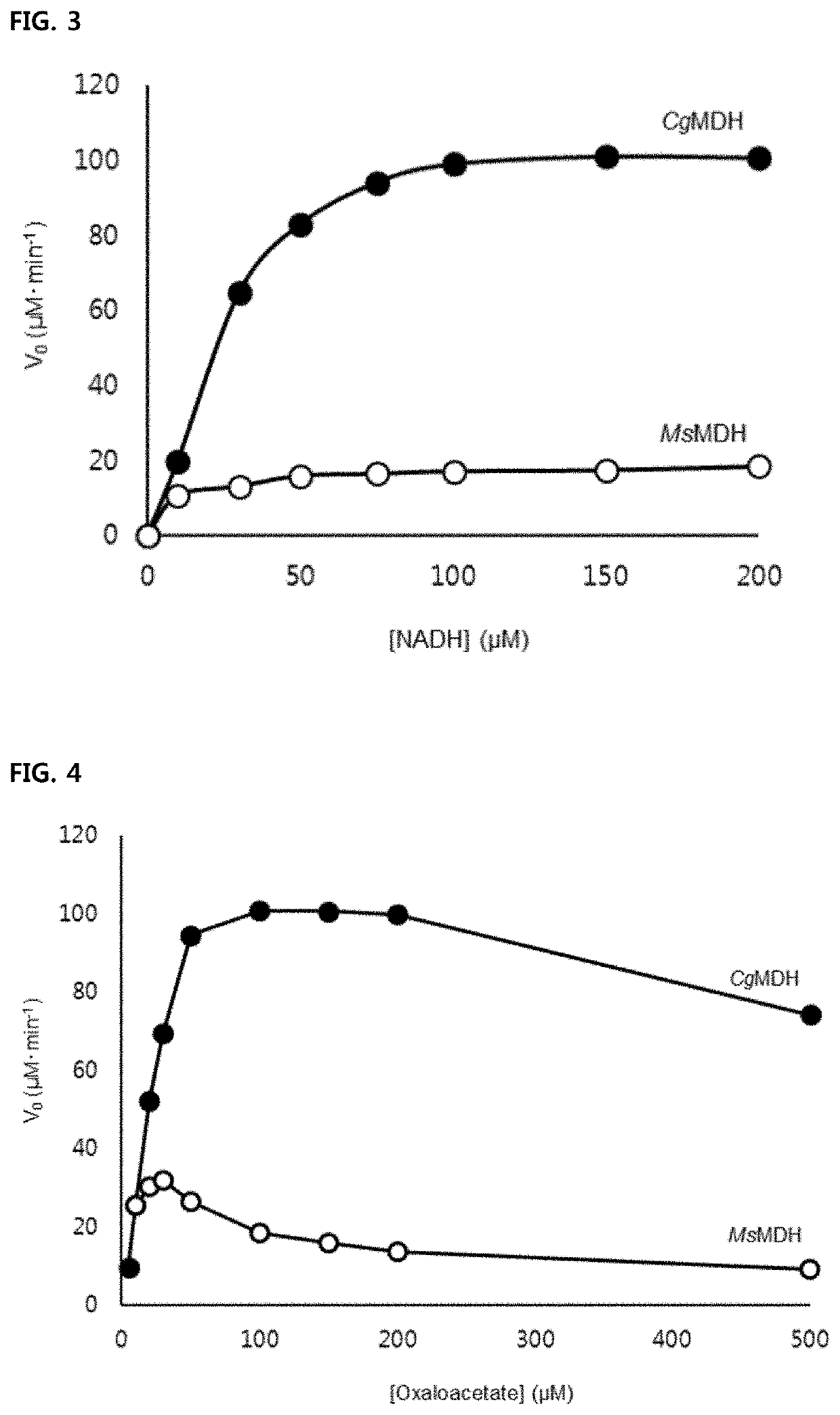Mutant microorganism introduced with highly active malate dehydrogenase for producing succinic acid and method of producing succinic acid using the same
a technology of malate dehydrogenase and mutant microorganisms, which is applied in the direction of bacteria, biochemical equipment and processes, fermentation, etc., can solve the problem of low productivity of succinic acid
- Summary
- Abstract
- Description
- Claims
- Application Information
AI Technical Summary
Benefits of technology
Problems solved by technology
Method used
Image
Examples
example 2
[0061]Expression and Purification of MsMDH, CgMDH, EcMDH, YlMDH and Mutant Enzyme Proteins Thereof (MsMDHG11Q, CgMDHQ20G, MsMDHL101Q, CgMDHQ117L, CgMDHS242A)
[0062]The overexpression vectors (PET30a:MsMDH, pET30a:CgMDH, pET30a:EcMDH, and pET30a:YlMDH) prepared in Example 1 were transformed into E. coli BL21 (DE3)-T1R and cultured in LB medium containing 100 μg / mL of kanamycin at 37° C., and when OD600 was 0.6, expression was induced through IPTG. After induction of expression, the cells were further cultured at 18° C. for 20 hours so as to express the corresponding enzyme proteins. The resulting culture solution was centrifuged at 5,000 g for 15 minutes at 4° C. and the cells were then harvested and were lysed by sonication in a buffer A (40 mM Tris-HCl, pH 8.0) kept cold on ice. The cell debris was removed from the obtained cell lysate through centrifugation at 11,000 g for 1 hour. The final supernatant was applied to Ni-NTA agarose beads and MDH proteins with histidine tags were se...
example 3
[0063]Measurement of Oxaloacetate Reduction Activity of MsMDH, CgMDH, EcMDH, YlMDH, MsMDHG11Q, CgMDHQ20G, MsMDHL101Q, CgMDHQ117L, and CgMDHS242A
[0064]The NADH is used as a cofactor for the oxaloacetate reduction activity of MDH. As a result, NAD+ is produced. The activity of MDH can be measured on an hourly basis through a spectrophotometric method based on the unique absorbance properties of NADH at 340 nm. The composition of the final reaction solution for comparative activity measurement was as follows: 0.1M Tris-HCl (pH 8.0), 100 μM NADH, 100 μM oxaloacetate, and finally 3 nM purified MDHs (MsMDH, CgMDH, EcMDH, YlMDH). The composition of the final reaction solution for measuring the activity of the mutant enzymes (MsMDHG11Q, CgMDHQ20G, MsMDHL101Q, CgMDHQ117L, CgMDHS242A) was the same as the composition for measuring the comparative activity. The kinetic activity was measured using final reaction solution while varying the concentration of oxaloacetate and the concentration of N...
example 4
[0065]Crystallization and Structural Analysis of CgMDH and MsMDH
[0066]Initial crystallization of the purified protein was conducted at 20° C. using a screening kit (Hampton Research, CA, USA) through sitting-drop vapor-diffusion. Each experiment was conducted by equilibrating a mixture of 1.0 μL of CgMDH or MsMDH protein and 1.0 μL of a reservoir solution with regard to 0.5 mL of a reservoir solution. CgMDH crystals were found under several crystallization screening conditions and after several cycles of optimization through hanging-drop vapor-diffusion, the crystals having the best quality were found under conditions of 18% PEG 3350, 0.2 M MgCl2 hexahydrate, and 0.1 M HEPES. In order to determine a substrate-binding structure, crystallization was conducted with malate and NAD+ as a substrate to obtain crystals under the same conditions. In the case of MsMDH, high-quality crystals with a size of 0.3×0.3×0.1 mm were obtained in 16% PEG3350 and 8% Tacsimate at pH 6.0 and X-ray diffrac...
PUM
| Property | Measurement | Unit |
|---|---|---|
| pH | aaaaa | aaaaa |
| pH | aaaaa | aaaaa |
| concentration | aaaaa | aaaaa |
Abstract
Description
Claims
Application Information
 Login to View More
Login to View More - R&D
- Intellectual Property
- Life Sciences
- Materials
- Tech Scout
- Unparalleled Data Quality
- Higher Quality Content
- 60% Fewer Hallucinations
Browse by: Latest US Patents, China's latest patents, Technical Efficacy Thesaurus, Application Domain, Technology Topic, Popular Technical Reports.
© 2025 PatSnap. All rights reserved.Legal|Privacy policy|Modern Slavery Act Transparency Statement|Sitemap|About US| Contact US: help@patsnap.com



